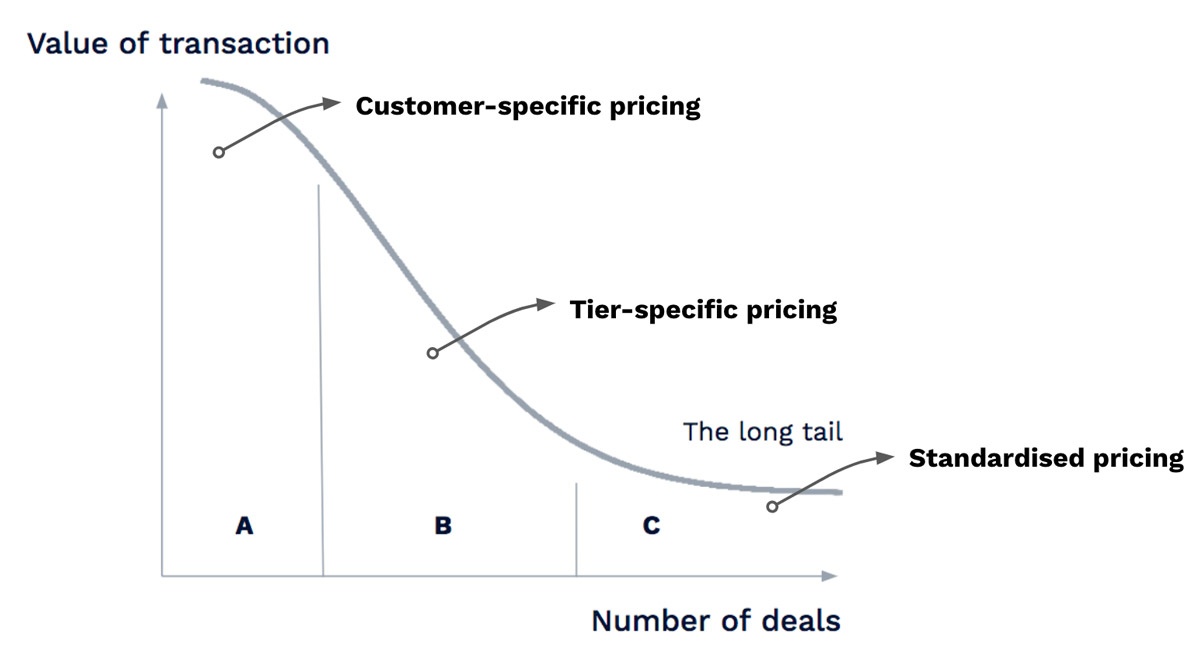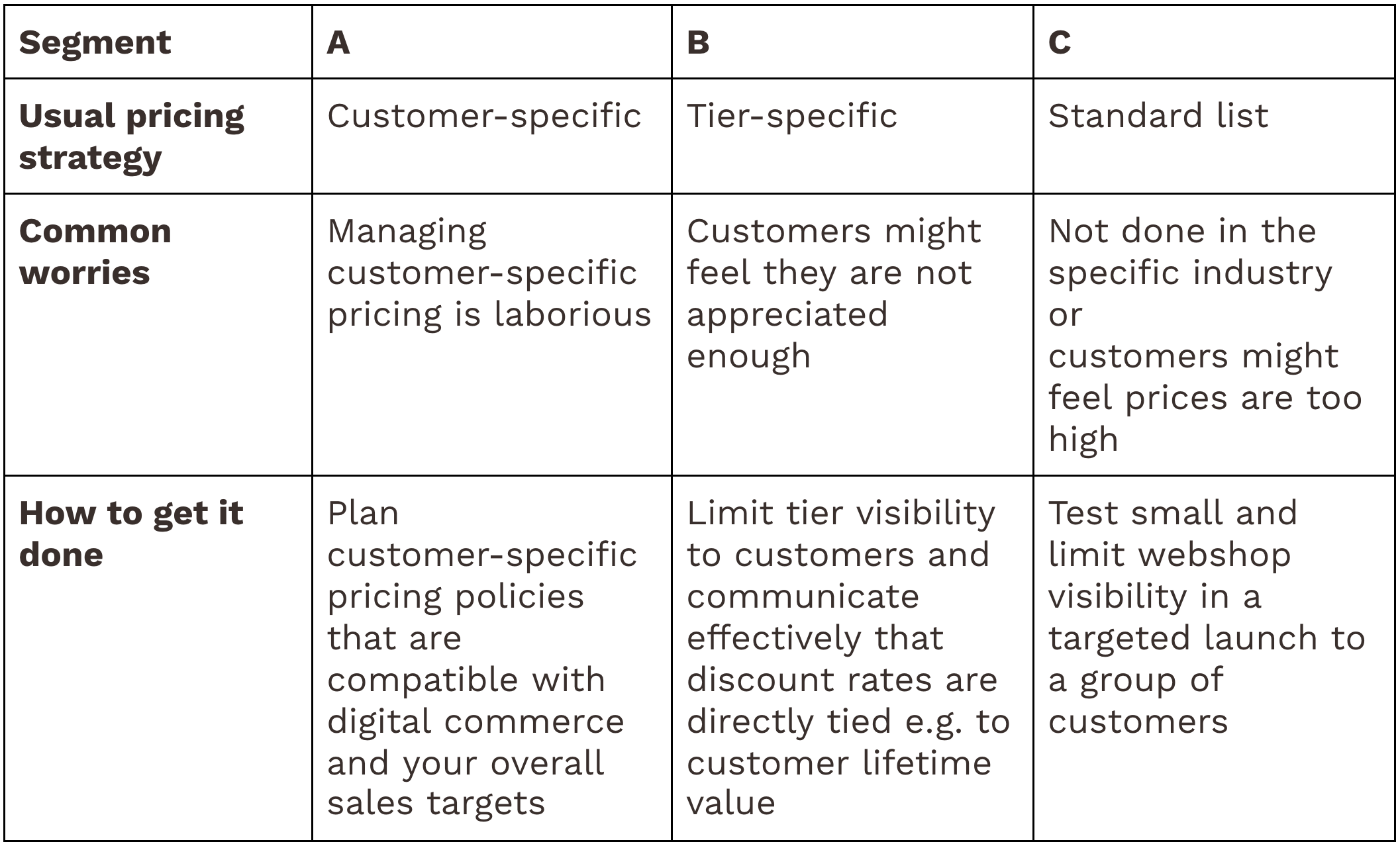The Data Handbook
How to use data to improve your customer journey and get better business outcomes in digital sales. Interviews, use cases, and deep-dives.
Get the bookLaunching and growing a B2B webshop is more than an IT investment. Digital commerce changes the sales processes fundamentally and requires new capabilities to manage customer relations.
Fundamentally, launching a new webshop is about trust-creation and transparency. For many companies, implementing a B2B webshop is actually the first time they have to put standardized and public pricing into effect. Pricing transparency is slowly but surely disrupting industries.
But still, many suggest that their potential customers will be scared off by seeing high prices. What is driving the disruption, even more, is proven inbound methodologies that drive the customers one step further on their buyer journey. This is done by providing the customer an essential piece of information, the price, that they would anyhow need in order to make the purchasing decision. Companies who embrace the controversial and go public with their prices are generally getting better quality leads.
What is wrong with current sales processes and pricing models
More often than not, an old-school sales process relies on exclusivity. Salesperson meets the customer with a proposal listing customer-specific prices. There is an age-old saying that goes “special price only for you my friend”. In this sales process pricing is an art. But the customer has all the power. They can ask for lower prices, to get more discounts and so forth.Customers are searching and evaluating different solutions from different channels. If you’re selling commoditized products or services with high competition, the old-school sales process where special discounts are the way to close a deal only amounts to a race to zero. If there are no common pricing practices to follow, individual salespeople can try cosmetic fixes and bake service fees into product prices. When the same product prices become standardised and are revealed to the public, the customer finds out that they paid extra and the relationship suffers.
Even more than the change in B2B purchase behaviour, the old-school sales processes in B2B companies seem to be influenced by the organisation’s structure and goals. In addition to having customer-specific pricing, the pricing information might be fragmented across business units, market areas, and even different salespeople. If sales are guided more by revenue than profitability goals, it might make more sense to lower unit prices inside individual contracts. Raising prices later can be difficult and result in churning customers.
How B2B digital commerce challenges the old sales processes and pricing
Many companies see a B2B webshop as a way to scale the current sales and serve smaller customers. The people you currently have in sales might not have time to serve the smaller segment efficiently, and a digital commerce channel, such as a webshop, can also create a better overall customer experience for bigger customers by having an easy-to-use channel for ordering. As Juho Jutila mentioned already in part 1 of our digital commerce B2B -series: When the transaction size gets smaller, the unit price must go up. Whether or not serving bigger or smaller customers, a B2B webshop implies transparency, standardisation, and ease of access.
Technologically, a microservices approach for building a B2B webshop (case example) might be the only robust approach that fits elaborated enterprise architectures and complex customer, contract and category specific pricing models. The bottleneck of efficient pricing probably still lies in organisational capabilities such as agreeing on and defining uniform prices, pricing practices and policies for customer-specific pricing. My colleague Eero Martela has some experience on how any B2B webshop disrupts these policies: “Launching a B2B webshop can be an essential driver for compliance in unified pricing practices across the whole organisation.”
"Launching a B2B webshop can be an essential driver for compliance in unified pricing practices across the whole organisation"
The rising trend of B2B inbound marketing is also paving the way for the B2B digital commerce. Compared to B2C webshops, the sales cycles in B2B are typically longer. On the other hand, B2B customers expect consumer-grade user experience. From the sales perspective, a B2B webshop is perfect! It extends the inbound content marketing and lead generation practices. These things are well understood and practiced in the B2B sales. This same attitude towards value creation can help the customer take the next step towards making a purchasing decision.
Pricing strategies geared towards digital growth
Your pricing strategy needs to be scalable, especially if you are going for the B2B long tail. A good starting point is not to think about creating customer-specific pricing for smaller customers. In digital commerce, your pricing cannot be an art, but rather a science. However, you have to maintain the customer-specific pricing in some system, and it might as well be better to put it into the webshop’s database instead of individual contracts or spreadsheets.

Picture 1: How different customer segments, based on value and number of transactions can be used to imply pricing strategy.
Starting off with standardised pricing might be a good idea — especially if a webshop is designed for “the long-tail”. For segment C pricing can be standard, while in segment B the prices can be defined by a pricing tier. In segment A, it might still be important to provide customer-specific pricing. When those smaller fish in segment C or B grow into one it might make sense to get an account manager involved.
In the model (picture 1) pricing becomes very strategic when you start specifying the thresholds for different segments. Where a segment C customer becomes eligible for segment B pricing segments, and so forth. Having a rough customer lifetime-value (CLV) as a basis of classification, instead of optimising value for a single transaction is key. This threshold can be further used in automation: when a small fish grows big, it becomes eligible for different pricing models.

Table 1: Summary of segments, pricing strategies, usual threats and how to manage them effectively.
Pricing needs constant updates which can turn into a bottleneck if all traditional pricing schemes need to be created in a webshop. Tier-based pricing can be quite manageable if the number of tiers is only a handful. If there are hundreds of customer-specific pricing models, the task might be cumbersome. In many situations, the reality is that there are no standard list prices.
Traditionally, the price acceptability is investigated and prices determined. However, digital commerce offers a lot more interesting ways to validate acceptable prices.
Prices do not need to be static. Digital commerce allows for dynamic pricing, whether it is following general market prices and competitors’ offers or optimising for webshop conversions. In the ideal world, the customer decides the correct price and we constantly learn about acceptable price levels.
Transparent pricing needs to be complemented with well-crafted value propositions
For many forerunners in B2B, transparent pricing is a value in itself. Digital commerce is a different game: if competitors show prices online and you do not, you will not even be included in further comparisons. But of course, it is not enough that you provide the price of a product or service. Let your customers know what they get and exactly how much they pay.
Still, a webshop is not a substitute for a salesperson, but a complement. There are multiple use cases for salespeople to effectively leverage a webshop’s functionalities: from drafting proposals to predicting demand from activity on the webshop, and catering to the changing needs more effectively. Whatever the functionalities and content in the webshop, transparent prices must be balanced with value propositions that justify the price. Owning the conversation about pricing and the value that you provide for the price is one of the key messages to create trust.
Did you get inspired? How about further optimising your digital commerce – with the help of our free Digital Commerce Canvas. With the Digital Commerce Canvas, you get a thoroughly holistic yet light kickstart for analysing, planning or redesigning your digital sales and customer acquisition in a 1 to 2 hour workshop.
The Data Handbook
How to use data to improve your customer journey and get better business outcomes in digital sales. Interviews, use cases, and deep-dives.
Get the book




